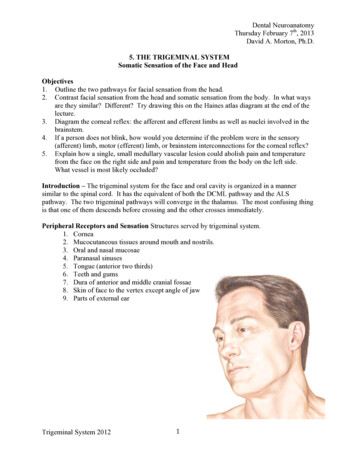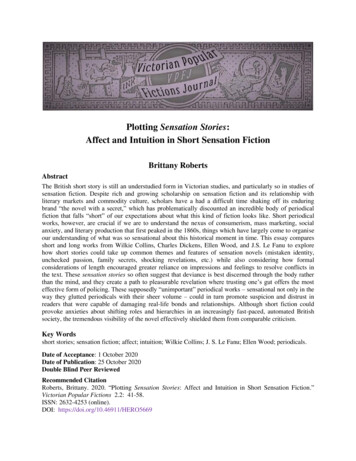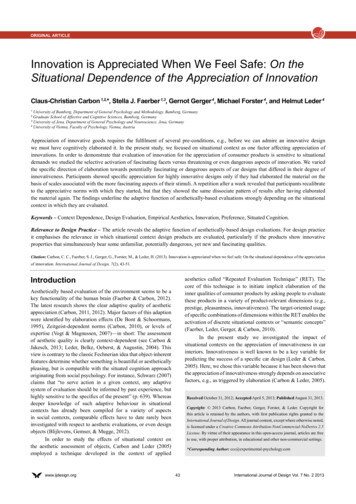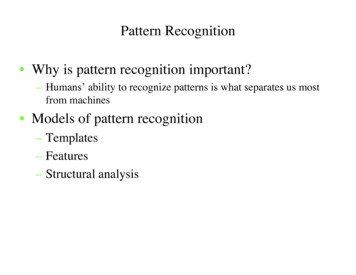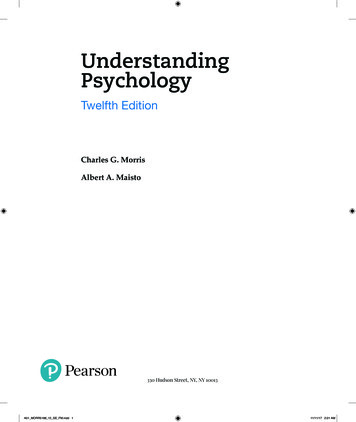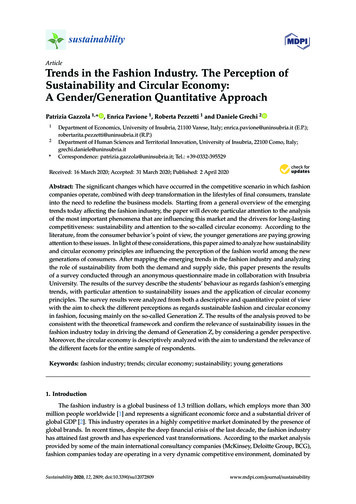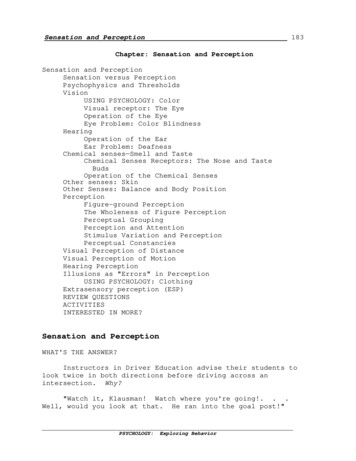
Transcription
Sensation and Perception183Chapter: Sensation and PerceptionSensation and PerceptionSensation versus PerceptionPsychophysics and ThresholdsVisionUSING PSYCHOLOGY: ColorVisual receptor: The EyeOperation of the EyeEye Problem: Color BlindnessHearingOperation of the EarEar Problem: DeafnessChemical senses—Smell and TasteChemical Senses Receptors: The Nose and TasteBudsOperation of the Chemical SensesOther senses: SkinOther Senses: Balance and Body PositionPerceptionFigure-ground PerceptionThe Wholeness of Figure PerceptionPerceptual GroupingPerception and AttentionStimulus Variation and PerceptionPerceptual ConstanciesVisual Perception of DistanceVisual Perception of MotionHearing PerceptionIllusions as "Errors" in PerceptionUSING PSYCHOLOGY: ClothingExtrasensory perception (ESP)REVIEW QUESTIONSACTIVITIESINTERESTED IN MORE?Sensation and PerceptionWHAT'S THE ANSWER?Instructors in Driver Education advise their students tolook twice in both directions before driving across anintersection. Why?"Watch it, Klausman! Watch where you're going!. . .Well, would you look at that. He ran into the goal post!"PSYCHOLOGY:Exploring Behavior
Sensation and Perception184Moments later, "Klausman, how many times have I told you?You've got to look where you're going! What if that had been adefensive player from the opposing team? How do you feel?""I feel OK, coach, but I've got a bad ringing in my ears."What causes the ringing in your ears that you may hear afterbumping your head?How can ice skaters in a dancing routine make high-speedspinning turns without getting so dizzy that they lose theirbalance?Some experimenters have reported frequent successes intransmitting images and thoughts between widely separatedindividuals. Does extrasensory perception exist?Sensation and perceptionidentify processes that differprimarily in their complexity.We have a greater number ofsenses than is widely believed.Psychophysics is the study ofthe relationship betweenphysical events and ourexperience of those events. Theabsolute threshold is thesmallest stimulus that arouses a sensation. The differencethreshold is the smallest change in any stimulation that can bedetected.The stimulus for vision is light, which has three physicalcharacteristics: wavelength, intensity, and pureness. Thepsychological attributes are hue, brightness, and saturation.Complementary colors, as well as other colors, may be mixed inan additive or subtractive process. The receptor for vision isthe eye, which contains rods for black-white vision and conesfor color vision. Vision is poorest at the blind spot and bestat the fovea. Dark adaptation and the Purkinje Shift bothresult from the shift from cone- to rod-vision. Color blindnessaffects mainly males, but it is a relatively slight visionproblem compared to blindness.The physical stimulus for hearing is pressure waves, whichhave three physical characteristics: frequency, amplitude, andcomplexity. We hear sounds in terms of pitch, loudness, andtimbre. The receptor for sound is the ear, within which haircells in the cochlea stimulate the auditory nerve. Two majortypes of deafness include conduction deafness and nervedeafness.PSYCHOLOGY:Exploring Behavior
Sensation and Perception185The physical stimuli for the chemical senses are, forsmell, gas and for taste, liquid. Several systems of "basic"smells have been proposed with varying degrees of success. Thefour basic tastes are sweet, sour, bitter, and salty. Thereceptor for smell is the nose, and the lock-and-key theory isthe most successful attempt to explain how gases activate oursense of smell. The receptor for taste is the taste buds in themouth. Specific patterns of taste-bud activity seem to beassociated with specific tastes. The common cold shows theextent to which smell is the more important of the two chemicalsenses.The physical stimuli for the skin senses are contact andtemperature. They give us our sense of touch (or pressure),pain, hot, and cold. The physical stimuli for the vestibularsense are rotation and the position of the head. These give usour "sense of balance." Three semicircular canals and twootolith organs act as receptors. We sense our body positionfrom receptors located in our muscles, tendons, and joints.Perception is based on certain factors of organization,including the figure-ground relationship. Another factor is thewholeness of figures (determined by symmetry, closure, andfamiliarity). A third is the grouping of elements (based onproximity, similarity, continuation, and common fate). Threeother factors importantly involved in perception includeattention, variations in stimulus input, and the constancies(shape, size, brightness, and color).There are two important jobs in visual perception. One isjudging distance or depth, which is based on stimuli and cueswithin the organism. The other is detecting motion, which isbased on the order in which sensing cells fire and/or movementrelative to the environment or another object. In perceivingsound, our ability to locate a sound source is based on onsettime, relative loudness, and phase differences of the soundwaves reaching each ear."Errors" in perception occur when the constancies fail.The resulting illusions are of four types -- straight-line,bisecting or orientation, compound straight-line, and figure.Such information can be applied in designing clothing to createspecific impressions. Subliminal perception is feared more thanis warranted. Extra-sensory perception remains controversialand is still lacking in hard scientific proof.The Review Questions will help with mastery of thematerials covered in this chapter. After reading the chapteryou may be interested in trying some of the suggestedACTIVITIES. Further information about selected topics withinthis chapter is available in follow-up readings suggested in theINTERESTED IN MORE? section.PSYCHOLOGY:Exploring Behavior
Sensation and Perception186Sensation versusPerceptionIn the study ofsensation and perception, one ofthe basic questions concerns howthese two concepts relate toeach other. Several years ago anationally broadcast televisionshow tried to clarify how humansrespond to stimuli. The insideof the head was depicted ashaving a large television screen. On the screen were displayedall of the stimuli viewed by this human. Within the big headlived a much smaller person, who simply pulled levers to makethe larger human respond. While this presentation explainsnothing (who or what makes the little person respond?), it doespoint out three basic elements involved when humans react totheir environment. The first is the stimulus -- both itsphysical characteristics (what it is) and its psychologicalattributes (how we react to it). The second is the receptor,which receives the stimulus and sets the reaction in motion.Finally, there is the human organism itself -- both its priorexperiences and its current physiological state. These threeelements -- stimulus, receptor, and organism -- combine todetermine the ways in which we respond, as we see in the Figure.A sensation occurs any time a stimulus activates one ofyour receptors. Perception occurs when you apply yourexperience to interpret sensations. In this chapter we discussboth our environmental stimuli and receptors as well as the morecomplex processes of perception.The differences betweensensation and perception aremore a matter of conveniencethan importance. In fact, somedeny such distinctions can bemade. Perception is composedof sensations to which thebrain reacts. But there is noclean separation of sensationsand perceptions. In the eyethere are cells which fire only if a stimulus is moving in aparticular direction -- for instance, left to right. The samecell does not fire if an identical stimulus is moving right toleft. In the very act of firing, this cell has alreadyPSYCHOLOGY:Exploring Behavior
Sensation and Perception187initiated the perception that the object is moving left toright. A single note from a guitar is a simple event. It canbe called a sensation throughout the processes involved inreceiving the note and communicating it into the brain. Withinthe brain, however, combining the notes of the theme and theirrhythm so you can recognize a song you know is a much morecomplex process of perception. There is no clear line ofseparation as to when something is a sensation and when it is aperception. It’s better to think of the two processes asoccupying opposite ends of a continuum stretching from sensationto perception with a gray or fuzzy border separating the twoprocesses.How many senses do we have? The answer depends on how youdefine a sense. If you do it in terms of different kinds ofreceptors, then we have about ten. These include vision,hearing, smell, taste, the skin senses (pressure, hot, cold, andpain), as well as balance and body sense, or kinesthesis. Onthe other hand, in terms of the stimuli to which we can react,there are about six senses, based on our sensitivity to light,sound, gas, liquids, solids, and body position and motion.Psychophysics and ThresholdsThere is a fairly precise relation between what happens outin the physical world and the internal events to which we react-- the worlds of sensation and perception. But the relationshipis not perfect. Psychophysics is the branch of psychology thatstudies the relations between physical events and the relatedpsychological experiences. As we examine each of our senses,notice that we divide our discussion into two parts. We discussthe physical (real world) stimulus, such as light or gas or coldtemperature. And we discuss the psychological experience, suchas vision or smell or touch.Look at the illustration for a moment. Now close your eyesand cross the index and middle fingers of your left hand likethe hand shown. Rub a pencil or the index finger of your otherhand back and forth through the notch formed by your two crossedfingers. What do you feel? Probably you feel as if two pencilsor fingers are touching your left hand. You are not perceivingwhat is actually happening, so there is some "slippage" betweenreal world events and your perception of them. This is oneexperience studied by psychophysicists.The absolute threshold is the smallest amount of a stimulusthat can be detected by an organism. Your "absolute" thresholdmay be different from mine. The partially deaf person'sabsolute threshold for sound is higher than either yours orPSYCHOLOGY:Exploring Behavior
Sensation and Perception188mine. Thus, it's an absolute threshold in that it's the lowestamount of a stimulus that can be detected. However, it isneither an absolute threshold in the sense that it's the samefor everyone, nor in the sense that it’s constant within any ofus.The just-noticeabledifference (or j.n.d.) is theamount by which any stimulusmust be changed in order forthat change to be detected.The difference threshold is theamount of the change necessaryin order for the change to bedetected half of the time.Weber's Law states that thegreater the absolute amount ofany stimulus, the larger theamount of relative change that will be required in that stimulusbefore an observer can detect it. The formula for Weber’s Lawis (Delta S)/S K, where Delta change, S stimulusmagnitude and K a constant.See Feature 1 for an exampleof how this works.Feature 1"I See the Light"A psychologist named Weber was the first to observe that the size of thedifference threshold depended on the level of stimulation at which thatthreshold was being measured. He found that as the level of stimulationincreased, the size of the just-noticeable-difference also increased. Inother words, the higher (or larger or louder) the stimulation, the more thatstimulation must change before you can detect that change.Using a 50-100-150 watt light bulb, it is very easy to demonstrate thisconcept. When you turn the bulb on to its lowest setting—5O watts—theincrease from no light in even a semi-dark room is quite noticeable. As youswitch from 50 to 100 watts, the light grows noticeably brighter. Now switchit once more from 100 to 150 watts. This third change involves the sameincrease in wattage (the physical stimulus) as the previous two changes, butit causes a much less obvious change in the apparent brightness of the light.Although the level of stimulation became equally greater with each increase,the same physical change (an increase of 50 watts) was perceived to besmaller as the base level of the bulb was brighter. There is not a 1:1PSYCHOLOGY:Exploring Behavior
Sensation and Perception189relationship between increases in physical stimulation and apparent orperceived increase in the accompanying psychological experience.VisionIn studying the manyprocesses of sensation andperception, the most widelystudied and understood isvision. The physical stimulusfor vision is light whichstimulates the eye. Light fromany source has three physicalcharacteristics: wavelength, intensity (or amplitude), andpureness. These characteristics are seen by us as hue,brightness, and saturation (see Table 1).Table 1Light stimuli and how we experience themPhysical Characteristicof Light WaveWhat We PerceiveWavelengthIntensityPurenessHue (or color)BrightnessSaturationChanging any of the physical characteristics of light wavesmakes a difference in our experience of the light, and it altersthe operation of the eye.The source of most of our light -- the sun -- emits whitelight, which is a mixture of all light wavelengths. This can bedemonstrated by passing sunlight through a prism, as seen in theFigure. A prism spreads light out into the colors of thevisible spectrum, as illustrated. Hue identifies the perceivedcolor of a particular wave. As wavelength changes, hue alsochanges.PSYCHOLOGY:Exploring Behavior
Sensation and Perception190As the intensity, amplitude, amount, or magnitude of alight wave increases, the result is an increase in perceivedbrightness. Thus, brightness is related to the amount of lightpresent. The light meter, or photometer, in a camera measuresthe intensity of physical light waves entering the lens.A totally saturated color is a pure light wave, but wedon't see these very often. About as close to pure color as yousee in the everyday world is the colors of a rainbow produced ona day of clear air. A pure red would have light waves of onlyone particular wavelength. An unsaturated light must be black,gray, or white. As you add white light to a pure color, thecolor becomes less saturated. If you mix all colors together,you recreate white light again. Saturation is also sometimescalled purity. This refers to the extent to which a particularhue is mixed with white or other light. Hue, brightness, andsaturation must all be mentioned to describe fully any lightsource. All three dimensions represented in the color solid canbe seen in the illustration. Difficulties in perceiving colorcan lead to various problems with vision, ranging from relativemild color insensitivities to total color blindness and -- atthe worst -- blindness.The color solid,illustrated in the Figure, isused to determine what happenswhen colors are mixed. Twocolors that are directlyopposite one another on thecolor circle part of the solidare complementary colors. Ifthey are mixed together, theresult is gray.We use the color solid only for predicting additive mixingof spectral colors. The hue depends on the light waves whichare added together. (An additive mixture of several colorsyields white.) If we were mixing paints -- which is asubtractive process, the results of our mixtures would be quitedifferent. The pigment of paint absorbs almost all but onecolor of the spectrum -- as does colored glass. The subtractivemixture of several colors yields black.USING PSYCHOLOGY: ColorAn interesting application of the principles of sensationand perception involves their application to how we dressPSYCHOLOGY:Exploring Behavior
Sensation and Perception191ourselves or decorate our environment. Colors as well as shapesand lines can play a vital role in projecting an image andcreating a mood. Think of the many common expressions thatrecognize this fact: "seeing red," "green with envy," "feelingblue," "in a brown funk," "purple passion." Some colors arecool, such as blue. Yellow, orange, and red are warm colors.Green is the only color that looks cool in summer, warm inwinter. Do you tend to wear brighter colors on a gloomy day?Of course, some colors are simply more becoming to you thanothers. Your own coloring will make a difference. Wearing bluecan emphasize blue eyes. Wearing yellow can make a yellowishskin look sick. You can contrast clothing colors with your owncolorations, or choose them to harmonize.If you're going to wear two colors, it is best to wear twocomplementary colors, meaning colors directly across from eachother on the color circle. If using three colors, use colorsthat are about 1200 apart from one another on the color circle.So as not to appear too "loud" or flamboyant as a dresser, useless saturated colors.Blending in with the scenery can pose a safety hazard tohumans: pea green slickers are best for visibility on rainydays. Snow skiers are safer not wearing white. Bicycle ridersare advised to wear something white at night. (Of course, dayglo and fluorescent colors are helpful too.) You can extend thesafety principle to your car as well. What colors would make itmore visible in a fog, at night, or on a rainy day? The mostvisible? White!Analogous color harmony uses colors that are next to oneanother on the color circle. If you choose these, you shouldstick to one primary color. Now that you have thought about theeffects of color, you can experiment with them to see what worksbest for you.Of course the lessons of dressing also apply to the choiceof colors in fixing up your room or decorating in general.Again, apply the principles of perception to gain control overhow your environment (and you) will be perceived.Visual receptor: The eyeThe receptor for visible light is the eye, diagrammed inthe Figure below. The eye is in many ways similar to a camera,but it is much more complex. Light enters the eye through thepupil and is focused by the lens. The light falls on theretina, which is similar to the film in a camera. The retina ismade up of two receptor elements, called rods and cones. Rodsare more light-sensitive than cones, so they are used to see inPSYCHOLOGY:Exploring Behavior
Sensation and Perception192poor light, especially at night. Cones are sensitive to color,but they demand more light to function. Rod vision iscomparable to black-and-white television; cone vision is similarto color television.The rods and cones connect with neurons that form the opticnerve, which relays visual information to the brain. The pointat which these neurons exit from the eye is called the blindspot. It is a very small portion of the retina that has noreceptor cells. Stimulation on the blind spot will not bereceived by the brain. Read the Think About It for an exampleof the effect of the blind spot in each of your eyes.Think About ItThe question:Instructors in driver education classes often advise theirstudents to look twice in both directions before driving across anintersection. Why?The answer: If you look to the right and to the left only once, it ispossible that the image of a car coming from the right might fall on theblind spot of one eye. It might then be obscured from vision in the other eyeby the right front roof support of your car. If the approaching car is movingfast enough to hit you, then looking again at the same spot will prevent anaccident. This should allow enough time so that the image of that car wouldnot fall on your blind spot both times. The figure shows the location of theblind spot that exists in each of your eyes.PSYCHOLOGY:Exploring Behavior
Sensation and Perception193If you look at something, you cause the light rays fromthat object to fall on your fovea -- the focal point of youreyes. The fovea is the point of greatest concentration of coneson the retinal surface. At the edge of your visual field,images are sensed only by rods. Thus, color vision is best atyour point of focus and absent at the edge.Operation of the EyeThe difference between rodand cone vision can be shown bytesting your absolute thresholdfor light after you walk fromsunlight into a darkened room.We become more and moresensitive to dim flashes oflight during the first 30minutes after coming out of thedaylight. This process iscalled dark-adaptation. Itexplains the kind of awkwardexperience we've all had ingoing into a movie theaterduring the daytime and tryingto find a seat. Thirty minutes later, when we want somepopcorn, it is no problem to see our way clearly from our seatto the aisle. During that time our eyes have adapted to thedarkness, and the rods are now playing a much larger role.The physical stimuli thatare present at sunset are thesame as those occurring atsunrise. Yet, if you wereasked to paint a picture of asunset, you would tend to usemore purples and darker colors.To paint a sunrise you would bemore likely to use reds andoranges and yellows. Why?Because each day as you shift(at sunset, as depicted in theFigure) from cone to rod vision, you switch to receptors (yourrods) that are more reactive to dim light and the darker colors.This is called the Purkinje Shift. Having lived for many hourswith light being interpreted by your cones, you suddenly mustrely more on your rods. Rods are relatively more sensitive toPSYCHOLOGY:Exploring Behavior
Sensation and Perception194colors at the purple and blue end of the color spectrum.result, you perceive a sunset as more bluish and purple.As aThere is yet another visual process you have also probablyexperienced. Look at the illustration on the left for 30seconds, then shift your focus to the illustration on the right.This is a demonstration of negative afterimage.Positive afterimages don't occur as frequently as negativeafterimages. The best example can be achieved if you'll get upat 4 a.m. tomorrow morning. Stumble over to the bedroom lightswitch. Flash the room lights on and off again instantly. Whatwill remain in your visual field is a positive afterimage. Ifyou turn your head or eyes, the view of your room also turns.It results from overstimulating the rods and cones which arefully dark-adapted. It causes no harm, although you may havewinced a bit when the lights went on!Eye Problem: (Color) BlindnessAs you know, there are many physical disabilities to whichhumans may be subjected. An interesting visual effect is thatof color blindness, which can be assessed using a test such asdepicted in the Figure. It afflicts about eight percent of themen in North America, but less than one percent of the women. Atotally color-blind person sees the world only in blacks, grays,and whites, with no trace of color. However, such a person isvery rare. Most people who are called "color-blind" areactually just deficient in their ability to see one or morecolors.Red-green color blindness is the most common type. Suchpeople experience the world in terms of black, gray, white,blue, yellow, and any other hues that can be achieved by mixingtwo or more of these colors. (See the illustration.) Yellowblue color blindness is a less common form. These peopleperceive the world in terms of black, gray, white, red, green,PSYCHOLOGY:Exploring Behavior
Sensation and Perception195and mixtures of these colors. Typically, color-blind peopleotherwise see quite well.One disability -- the impact of which is only now beginningto be understood -- is that of total blindness. The problemscreated by blindness are basically two-fold.First, it is now thought that perhaps 80 percent of all theinformation we learn is first taken in by means of our eyes.Although education and communication are not totally eliminatedby blindness, they are made much more difficult. Learning toread Braille, the system of raised dots that serve as lettersand numbers, is one way the blind can use touch to partiallyovercome their disability.There are also the problems of navigation and locomotion.For ease in getting around and solving the problems of educationand locomotion, a good and well-trained sense of hearing canalso help compensate for deficits in vision.HearingAssuming normal operation of the ear, sound will bedetected any time three factors are present: First, there mustbe a vibrating source, or stimulus. Second, there must be amedium -- gaseous (as it usually is, like air), liquid,or solid -- for transmittingpressure waves from thatsource. (Remember the oldcowboys-and-native-Americanstrick of placing an ear on therail to find out from manymiles away whether or not atrain is approaching?) Finally,third, there must be a receptorpresent.PSYCHOLOGY:Exploring Behavior
Sensation and Perception196The physical stimulus for sound, then, is usually airbornepressure waves. These vibrating waves of pressure are known assound waves. Such changes in pressure are caused by thevibrations back and forth of the sound source itself. As istrue of light waves, there are three ways in which sound wavesmay differ. They may differ in frequency [or cycles per secondor hertz(Hz)], amplitude (or the amount of energy pushing thewaves), and complexity (or thenumber of simple frequenciesthat are represented in acomplex wave). To describe asound source you would need tospecify all three factors.These physical qualitiesof sound are perceived by us aspitch, loudness, and timbre, asshown in Table 2As sound waves increase infrequency, the pitch that youhear also increases. As theamplitude of a sound waveincreases, so does theperceived loudness of thatsound. Many older radioshave a "volume" controlinstead of a loudness control,but the control is incorrectlylabeled. A low note on achurch organ has a certainroom-filling ability unmatchedby any note from a piccolo.What differs between the organand the piccolo is volume, notnecessarily loudness.Timbre is essentially the complexity of a sound. Were youto pluck middle C on a guitar, the basic note would be the sameas one played on a piano. But the various overtones (caused byvibrations of other parts of the instrument) would allow youquite easily to distinguish a piano from a guitar. Too manytones and overtones all heard at once may sound like noise, asdescribed in Feature 6.4 when we discuss Hearing Perception. Atthe other extreme, deafness represents an inability to detectsound at all.PSYCHOLOGY:Exploring Behavior
Sensation and Perception197Table 2Sound stimuli and how we experience themPhysical Characteristicof Sound WaveWavelength (frequency of vibration)squeaks)Intensity (amplitude)PurenessWhat We PerceivePitch (bass sounds toLoudness (not the same asvolume)Timbre (complexity,due to overtones)Operation of the EarThe stimulus for hearingchanges its form several timesbefore stimulating the auditorynerve. Examine the diagram ofthe human ear. Sound wavesenter the auditory canal andcause movement of the eardrum.These two structures are calledthe outer ear. The eardrumchanges vibrations of the airmolecules into the physical movement of a solid, and the eardrumrelays these vibrations to three bones that connect to it -- themalleus (or mallet), the incus (anvil) and the stapes (stirrup).The bones of the middle ear are arranged to reduce the power ofthe signal relayed by the eardrum and to increase the physicaldistance of the motion being relayed. A good analogy is tothink of the mallet, anvil, and stirrup as being arranged likethe seesaw you rode in elementary school. If you were ridingwith an 800-pound gorilla, your end of the seesaw would be verylong; the gorilla’s quite short. The gorilla (serving as oureardrum) would move very little; you au contraire would beflying great distances up and down representing the changeachieved by the bones of the middle ear.The middle ear is filled with air, but it’s air tight, andthat presents a problem. When you leave sea level and drive upinto the mountains, you take sea level air with you. At somePSYCHOLOGY:Exploring Behavior
Sensation and Perception198point your eardrums will “pop" as they invert from concave toconvex. The pressure is released through the Eustachian tubewhich connects from your middle ear to the back of your throat.Each time you swallow, tubes open momentarily to reestablishequal pressure on both sides of your eardrum -- and it returnsto normal.The bones of the middle ear are connected to the cochleawhich constitutes the inner ear, where the auditory nerve isstimulated. As can be seen in the drawing, the cochlea is atightly coiled portion of the ear. It is liquid-filled, butprojecting up into it are very tiny hair cells that may bestimulated by activity of the liquid within which they are setand the basilar membrane on which they are mounted. Themovement of the basilar membrane causes the hair cells to bejammed against the tectorial membrane positioned just above thehair cells causing a shearing action on the hair cells. Bendingthese hair cells fires the auditory nerve. Physical movement ischanged into an electro-chemical impulse. The implications ofthis are summarized in the Think About It. As you might expect,loudness is conveyed in the auditory nerve by the number andrate of neurons firing. As the number and rate of auditorynerve cells firing increase, perceived loudness increases.Different cells fire to reflect difference in frequency; thecombination of cells firing determines to perceived timbre.PSYCHOLOGY:Exploring Behavior
Sensation and Perception199Think About ItThe question:your head?What causes the ringing that you may hear just after bumpingThe answer:The process that changes physical sound waves into thepsychological experience of sound is the movement or bending of the haircells in your cochlea. A blow to your head will sometimes bend these haircells. You will experience this as a sound or ringing sensation. As long asthe hair cells are bent this way, you will conti
sense of smell. The receptor for taste is the taste buds in the mouth. Specific patterns of taste-bud activity seem to be associated with specific tastes. The common cold shows the extent to which smell is the more important of the two chemical senses. The physical stimuli for the skin senses are contact and temperature.
